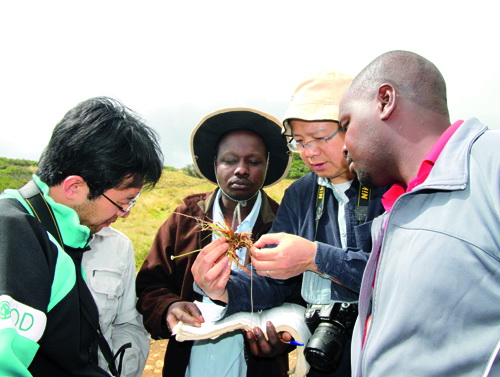|
 |
|
Chinese and African researchers examine plant specimens in the field (PHOTO BY LIU JIAN) |
A university van drove on a muddy road through the deep forests in Kenya's Aberdare National Park, which is 3,000 meters above sea level.
Professor Wang Qingfeng, a Chinese scientist, shouted "Stop!" and the vehicle rolled to a halt. A group of six Chinese and Kenyan scientists jumped out of the car and started conducting field research.
While taking pictures and collecting samples, they discussed on the genus and family of each plant they collected, and its value.
Twenty minutes later, Wang's voice rang out again, "Let's move!" The team quickly jumped into the van and continued their day-long trip.
In addition to visiting Aberdare National Park, the research team also climbed Mount Kenya and traveled to the Maasai Mara area to conduct field research from April 1 to 12.
This two-week joint botanical field research trip was part of the Biodiversity Conservation Studies in East African Flora project, launched in 2010 by the Wuhan Botanical Garden (WBG), the Chinese Academy of Sciences (CAS), and Jomo Kenyatta University of Agriculture and Technology (JKUAT).
Important work
The project is headed by Wang, Assistant Director of WBG. "In China and Africa, regions with some of the richest fauna and flora in the world, biodiversity has declined, owing to the causes such as pollution and population growth," he told ChinAfrica. "So it's necessary for China and African countries to cooperate in conserving their ecological resources."
"There is great potential for cooperation in biodiversity conservation between our nations, because both of them are developing countries, and face similar problems," said Dr. Robert W. Gituru, echoing Wang's view. He is a senior lecturer and director of JKUAT's Directorate of Sino-Africa Biodiversity Resource Conservation, which was established in 2010 under the joint research project.
Gituru feels that biodiversity conservation is critically important for Kenya. "The Kenyan economy is entirely dependent on biodiversity, as agriculture and tourism are the two pillars of our economy," he said. He believes biodiversity will bring development, "because plants not only have ornamental value, they also have medicinal and commercial value, so our research can benefit our people."
Biodiversity conservation also has cultural value, as African culture is closely intertwined with biodiversity. According to Gituru, almost every community in Africa has its own sacred trees under which they pray and sacrifice cows and goats. "If we don't conserve biodiversity, those trees will disappear, and our own culture will be in danger," he said.
Working together
For 37-year-old John Kamau Muchuku, a lecturer at JKUAT, working on this joint research project fulfilled one of his childhood dreams – learning about and understanding plants around the country. Initially, Muchuku only knew about a small number of plants found in central Kenya, where he was born. "But under this project I have had the opportunity to travel to many places and study plants as much as I can across Kenya," he said.
Since 2011, seven joint field research investigations have been conducted across Kenya. The sites of these investigations have included places such as Mount Kenya, Aberdare National Park, Gaogao Forest, Kilimambogo Forest and many other locations, according to JKUAT technologist Josphat Rutere Mbogo.
Chinese and Kenyan researchers have been working together on this joint research endeavor. Cooperation started at the very beginning of field work, and has continued through laboratory analysis, and up to the final publication of the group's research findings, according to Gituru.
"We share our strengths and weaknesses, exchange ideas and then cooperate to publish papers," he said. "If you cooperate with Chinese researchers, they will make sure that your name is acknowledged. Chinese researchers actually appreciate you being on their team," he added.
While Muchuku felt identifying plants is the first step of conservation, the knowledge gained by doing field work is also helpful for future research. "Through field research, I get to know what plants grow in which areas of the country, which are the endangered, and how the plants are growing and disappearing," he said.
|